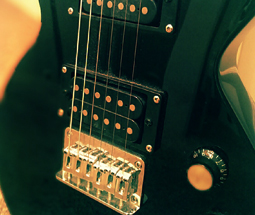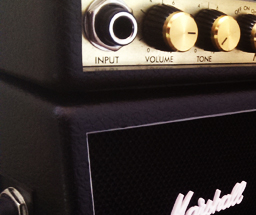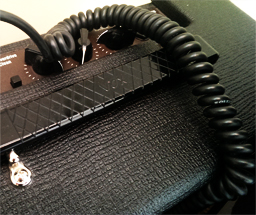Top 3 Guitar Chords For Beginners
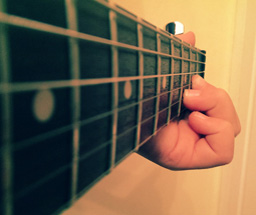
If you're just beginning guitar, you might be wondering which chords you should learn first. There isn’t a definitive answer to this question but we’d recommend starting out with G major, C major and D major.
These aren’t necessarily the easiest chords to learn, but they’re probably the most useful and here’s why.
Those T-Shirts Are Right!
There’s a good reason we chose to list the top 3 guitar chords and we’ll try to explain it without getting too bogged down in music theory.
Remember those t-shirts? You know, the one’s that say, ‘this is a chord, this is another, this is a third, now form a band’? Well, it’s no coincidence that they list 3 chords on the t-shirt and not just 2.
They list 3 chords because you should be able to play any song using a minimum of 3 major chords. This is because they contain all the notes of the scale. In this case, you're going to be learning the 3 major chords in ‘G major’ (the key of ‘G’). The chords are G, C and D and collectively they contain all the notes from the ‘G major’ scale.
G, C and D are some of the most commonly used chords in popular music and are used in literally thousands of songs.
Why Not Start With C, F and G?
That’s a good question. C, F and G are the major chords from the key of ‘C’ and there’s nothing to stop you from learning those first if you like. Hang on a minute - yes there is: it’s F MAJOR, which can be a real pain in the neck if you’re a beginner! Ok, so you could learn A, D and E (key of ‘A’) or D, G and A (Key of ‘D’), so why do we suggest G, C and D?
They're Used In Loads of Songs!
G, C and D are some of the most commonly used chords in popular music and are used in literally thousands of songs (we’ll list some of the most well-known later). Also, they’re not too difficult to learn and they sound really good together (hence their popularity).
Are you ready to learn them? Ok, here we go.
We've created an infographic to go with this lesson that you can download for free here.
G major Guitar Chord
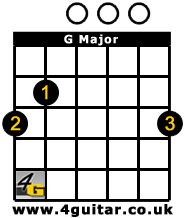
There’s a few different ways to play this chord but we suggest you start with the below:
- Place your 1st finger on the 2nd fret of the 5th string
- Place your 2nd finger on the 3rd fret of the 6th string
- Place your 3rd finger on the 3rd fret of the 1st string
- Leave the other strings open
- Play all the strings
It can be a bit hard to start out with but as this chord is so commonly used, it’s really worth the effort.
C major Guitar Chord
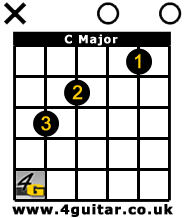
Again, there are a few variations but we’d start like this:
- Place your 1st finger on the 1st fret of the 2nd string
- Place your 2nd finger on the 2nd fret of the 4th string
- Place your 3rd finger on the 3rd fret of the 5th string
- Leave the other strings open
- Play all the strings except the 6th
It can be a bit of a stretch but it's well worth persevering with this chord.
D major Guitar Chord
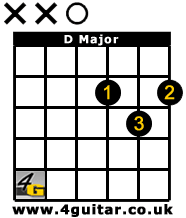
You should find this chord the easiest of the 3 to learn:
- Place your 1st finger on the 2nd fret of the 3rd string
- Place your 2nd finger on the 2nd fret of the 1st string
- Place your 3rd finger on the 3rd fret of the 2nd string
- Leave the other strings open
- Play all the strings except the 5th and 6th
Make sure you stretch your 3rd finger properly. When you’re just starting out, the 3rd finger can tend to get too close to the fret and deaden the note, so keep practicing the stretch.
Time For A Change
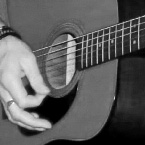
Once you’ve practiced all these chord shapes and are playing them cleanly, you need to start changing between the chords. This can be quite tricky to start with but, once you build up your muscle memory, you won’t even have to think about it.
When you change chords, you’ll probably feel like moving your 1st finger before the others. This is because your 1st finger is dominant. The thing is though, for a lot of guitar chord changes, you’re probably better off if you move some of the other weaker fingers first. It may feel counter intuitive to begin with but it’ll make your changes smoother in the long run.
G to C Chord Change
As we mentioned above, the trick here is to lead the change with the 3rd finger and not the 1st. You’ll then find that the other 2 fingers fall into place. It also makes for a really seamless transition. Don’t get disheartened if you struggle at first, G to C is a notoriously difficult change when you’re just starting out on the guitar, but you’ll definitely get there in the end.
C to D Chord Change
With this change, it’s important to move the 2nd and 3rd fingers initially, as they're already on the correct frets. They just need dropping down a few strings. If you lead with the 1st finger, you’ll find that your 3rd finger lags and makes the change a bit clunky.
D to C Chord Change
Once again, when you change from D to C, try to move your 2nd and 3rd fingers before your 1st. When fingers 2 and 3 are in place, you’ll find the 1st finger heading towards the 1st fret anyway.
C to G Chord Change
Here you need start by moving the 3rd finger down to the 1st string and getting the other 2 fingers up to the top strings.
I – IV - V Progression G to C to D
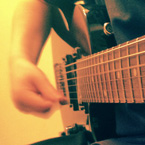
What you've learned above is a chord sequence known as a I – IV – V (1-4-5) progression. The 1st, 4th and 5th chords of a major scale are all major chords. The chords are indicated by roman numerals. This is a I – IV – V progression in the key of ‘G’. You could do the same in the key of ‘C’ in which case you would be using the chords of C, F and G.
This is a very common progression in all types of modern music. As we mentioned earlier, if you play this sequence in the key of ‘G’, you can play thousands of songs.
Before we list some songs (as we promised earlier) here are a few tips that might help you when changing chords on the guitar.
Chord Changing Tips For Guitar
These can be a great help.
- keep your fingers low over the fret board - conserves the movement you need to make when changing
- Keep your fingers vertical - helps stop you muting strings by mistake
- Visualise the chord in your head first - If you picture the chord in your head slightly before the change, you’re more likely to hit the chord cleanly (this is our favourite tip and really works, try it and see!)
Guitar Songs You Can Play Using G , C and D
If you’ve practiced the changes in the previous section, you should now be ready to tackle some of the songs we’ve listed below.
- Already Gone (Eagles)
- Blowin in the Wind (Bob Dylan)
- Good Golly Miss Molly (Little Richard)
- I'm A Believer (Monkees)
- Leaving on a Jet Plane (John Denver)
- Love Me Do (Beatles)
- Ring of Fire (Johnny Cash)
- Summertime Blues (Eddie Cochran)
- Sweet Home Alabama (Lynrd Skynrd)
- The Joker (Steve Miller Band)
- The Tide is High (Blondie)
- You Shook Me All Night Long (AC/DC)
This is just a drop in the ocean as loads of songs use these chords. It should be enough to keep you going for a while though! You could also take any song that uses the I-IV-V progression and play it in ‘G’ (some songs don’t sound quite as good in a different key but others are fine).
Anyway, good luck and enjoy learning!
We've created an infographic - 3 chords, 1000's of songs to go with this lesson.
Read our next article to learn more basic beginner guitar chords

